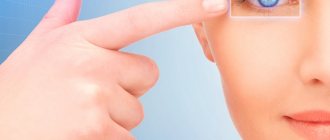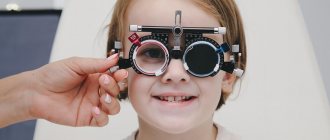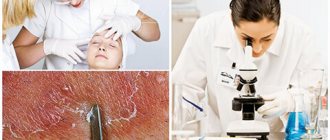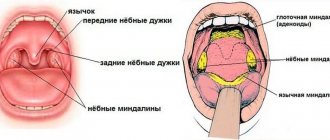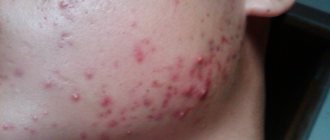In this article we will tell you:
- Types of eye angiopathy
- Causes of angiopathy
- Symptoms and diagnosis of angiopathy
- Angiopathy during pregnancy
- Treatment of angiopathy
- Prevention of angiopathy
- conclusions
Angiopathy of the retina cannot be called an independent diagnosis - rather, it is a pathological condition, a symptom. It occurs as a result of other diseases that specifically affect the blood vessels of the retina. And not only her, but the whole body. Typically, retinal vascular angiopathy in an adult is diagnosed after the age of 30. As soon as nervous regulation is disrupted, the vessels undergo negative changes.
Types of eye angiopathy
Angiopathy is not a separate disease, but evidence of the development of other diseases of the body that affect blood vessels, including disrupting the blood circulation of the retina. But retinal angiopathy cannot be ignored, as it can lead to very dangerous consequences for the body, including complete loss of vision.
The type of angiopathy usually indicates the disease that caused its occurrence. It could be:
- Traumatic angiopathy developing against the background of persistently increased intracranial pressure. It is provoked by injuries to the neck, brain, and compression of the chest.
- Hypertensive angiopathy of the retina. Hypertension often causes hypertensive angiopathy of the retina of one or both eyes. Arterial hypertension affects target organs, one of which is the eyes. Against this background, hypertensive retinal angiopathy is rapidly developing. The blood vessels of the fundus narrow unevenly, and venous branching appears. With retinal angiopathy of the hypertensive type, visual acuity is significantly reduced.
- Diabetic angiopathy of the retina, which is provoked by diabetes mellitus and impaired glucose metabolism.
- Macroangiopathy and microangiopathy. In the first case, large vessels of the eye are affected, in the second, the capillary walls become thinner and hemorrhage begins in the eye tissue.
- Hypotonic angiopathy is characterized by dilated arteries and venous pulsation.
- Reduced vascular tone deprives the body of normal blood flow. Blood clots form in the capillaries, causing hemorrhage in the eyeball and retina.
- Background angiopathy of the retina is characterized by the development of degeneration of its membrane against the background of various intoxications, vascular damage and other diseases.
- Venous angiopathy occurs due to the formation of stagnation in the blood.
- Blood clots and hemorrhages form directly in the eyeball. Blurred vision and progressive myopia are a consequence of venous dilations.
- Juvenile angiopathy (Eales disease) occurs before the age of 30.
The disease is often associated with tuberculosis, toxoplasmosis and other infections. Inflammatory vascular changes begin in the fundus of the eye with disruption of the blood supply to the retina.
What is retinal angiopathy?
Retinal angiopathy is a secondary condition that is a consequence of diseases affecting the vessels of the retinal membrane. More often it occurs in people over 30 years of age, but is sometimes diagnosed in adolescence.
In most cases, the pathological condition affects both eyes. Vascular damage can be local or systemic. In the first case, the pathological process manifests itself only at the level of the organs of vision. The systemic form reflects changes throughout the body. By examining the condition of the retinal vessels, the doctor can identify hypertension, atherosclerosis, diabetes and other dangerous pathologies at an early stage.
The pathological condition is characterized by dilation or narrowing of the blood vessels of the eye, hemorrhages, impaired blood flow, and the formation of blood clots. If left untreated, the consequences can be negative, including loss of vision.
Causes of angiopathy
Changes in retinal vessels can be caused by various reasons. This pathology develops differently and is the object of study not only by an ophthalmologist, but also by other doctors, such as a neurologist, endocrinologist, etc. This is due to the fact that in the eye the veins and arteries of the retina are accessible for observation, unlike the blood supply to other human organs .
There is a huge list of reasons leading to the development of angiopathy in both eyes. Here are just a few of them:
- Diabetes.
- Smoking.
- Blood diseases.
- Osteochondrosis of the cervical spine.
- Arterial or intracranial hypertension.
- Diseases of the nervous system.
- Hypotension or hypertension.
- Autoimmune diseases.
- Injuries.
- Heredity.
- Elderly age.
All changes impair the nutrition of the retina, resulting in oxygen starvation.
Causes of angiopathy
The following diseases can lead to disruption of the vascular system of the eye:
- hypertension or hypotension;
- atherosclerosis;
- diabetes mellitus and other endocrine disorders;
- eye injuries;
- autoimmune diseases;
- genetic predisposition.
In most cases, disorders of the vascular system affect the entire body, and angiopathy is combined with other diseases. Only angiopathy of traumatic origin can be local in nature.
The developing pathology causes serious functional and trophic disorders of the tissues and structures of the eye:
- dystonia of the vascular wall;
- vascular spasms;
- formation of atherosclerotic plaques;
- thrombosis of veins and capillaries.
Angiopathy always carries the risk of ischemic changes in the retina. Dysfunction of the circulatory system leads to slow metabolism, accumulation of metabolic products in tissues and hypoxia. Over time, this causes degeneration and functional failure of the light-sensitive cells of the eye and, as a consequence, loss of visual acuity.
Symptoms and diagnosis of angiopathy
As a rule, angiopathy is associated with the quality of vision. As soon as you notice that your sharpness has sharply decreased, “floaters” or “sparks” begin to appear in your eyes, the picture seems foggy and cloudy - immediately contact an ophthalmologist. Retinal angiopathy can be accompanied by such unpleasant symptoms as:
- Darkening in the eyes.
- Nose bleed.
- Deterioration of vision.
- Headache.
- Periodically occurring blur of objects.
- Sensation of pulsation in the eyes after intense visual work.
The problem is that in many cases, retinal vascular angiopathy manifests itself rather sluggishly at the initial stage. Therefore, some people are unaware of their problem, although patients feel that their vision has deteriorated. Over time, if the problem is not eliminated, a gradual rejection of the retinal tissue and their necrosis will begin, resulting in complete loss of vision.
Examination of the fundus is considered one of the most reliable methods for diagnosing angiopathy. The ophthalmologist observes changes in the lumens of blood vessels and their passages. In more complex situations, when serious changes occur in the retina or optic nerve head, additional diagnostic methods are needed:
- Ultrasound scanning of the eyes.
- Computer study of the boundaries of the field of view.
- Diagnostic examination using beam.
Damage to the blood vessels of the eye affects adults and children, but more often appears after 30 years.
Complications of the disease are expressed in optic nerve atrophy, narrowing of the visual field, loss of vision (partial, complete). There is a classification of diseases that cause retinal angiopathy. Accordingly, for effective treatment it is necessary to make an accurate diagnosis and find the cause that led to circulatory disorders.
Diagnostics
It is recommended to make preventive visits to an ophthalmologist at least once a year. Examination of the fundus is a simple, quick and painless procedure that allows the doctor to diagnose even the initial signs of angiopathy and begin treatment on time.
The Center for Vision Protection provides effective diagnosis of retinal angiopathy using modern equipment. If necessary, the doctor prescribes other studies, for example, duplex examination of the brachiocephalic vessels, ultrasound of the eyeballs, etc.
Angiopathy during pregnancy
Since in pregnant women the blood volume increases several times with the growth of the fetus, the blood vessels increase accordingly. Changes in the circulatory system cause angiopathy in pregnant women. Additionally, it is provoked by a hormonal factor, which is observed in the first trimester. In the second and third trimester, a decrease in peripheral vascular resistance occurs due to the functioning of the uteroplacental circulatory system. Another reason that can provoke angiopathy in pregnant women is gestosis. Identifying such a pathology in pregnant women carries risks, since standard treatment methods cannot always be used in this situation. In some cases where there is a risk of retinal detachment, the doctor may recommend a cesarean section.
Classification
Angiopathy is classified according to its etiology. The following types of condition are distinguished:
- Diabetic. Affects blood vessels in advanced stages of diabetes. As a result, blood flow and metabolism of the retina deteriorate, microcirculatory vessels are blocked, and visual acuity decreases. Angioretinopathy is accompanied by fibrous growth on the retina affecting the head of the optic nerve, which can lead to blindness.
- Hypertensive. It is caused by increased formation of vasoconstrictors - compounds that narrow blood vessels. Due to spasm of the arteries and veins, blood flow increases, the blood thickens, and blood clots form. Hardening of the vessels impedes the outflow of blood from the retina, and edema develops. The vascular walls become more permeable and are gradually replaced by fibrous tissue. Violation of the metabolism of the retinal membrane leads to deterioration of vision and the appearance of spots before the eyes.
- Hypotonic. Develops as a result of low blood pressure and may be accompanied by weakness and excessive thinness. Due to poor blood supply, the vessels lose their tone, and their pathological tortuosity develops. Small capillaries become thinner, compensatory filling of the veins occurs, followed by expansion. Slow metabolism leads to venous congestion and edema.
- Traumatic. Develops as a result of trauma to the chest, neck, head. Angiopathy is caused by an increase in intravascular or intracranial pressure, resulting in hemorrhages and traumatic detachment of the retinal membrane.
- Youthful. The second name is Eales disease. Diagnosed in people under 30 years of age. The cause of the condition may be autoimmune pathologies, but in most cases the etiology is not established.
- Mixed. Several forms of the pathological condition are layered, the condition is characterized by severe symptoms.
Treatment is prescribed depending on the type and cause of the pathological condition.
Treatment of angiopathy
Various methods are used in the treatment of retinal angiopathy. Therefore, it is important to understand exactly what form of the disease arose. After identifying the main cause, treatment is prescribed, aimed primarily at its correction, and the following is prescribed as an auxiliary treatment:
- Medications, eye drops.
- A low-calorie diet with limited simple carbohydrates and salt.
- Physiotherapeutic procedures.
- Massage of the cervical-collar area.
To prevent the appearance of angiopathy or delay its progression in case of damage to the ocular vessels, it is recommended to consult a specialist in a timely manner. Early initiation of treatment guarantees a favorable prognosis. If you have any chronic diseases or symptoms of visual impairment, do not delay visiting an ophthalmologist. Proper treatment and improved lifestyle can delay the development of the disease for a long time.
Symptoms of angiopathy
A serious problem is late diagnosis due to the absence of symptoms for a long time, while pathological changes in the eyes progress.
Often angiopathy is determined already when complications have formed.
Symptoms that may indicate retinal angiopathy:
- headache;
- episodes of blurred vision;
- pain in the eye area;
- decreased visual acuity;
- peripheral vision impairment.
The listed symptoms are a reason for an urgent visit to an ophthalmologist.
Prevention of angiopathy
Treatment is not just about taking medications. It is very important to maintain a proper diet and change your lifestyle. The diet should be low in salt and animal fats, high in potassium and magnesium. The patient should also increase physical activity. If intense exercise is contraindicated for a person, it is necessary to select a set of gymnastic procedures adapted to his activity and capabilities. Sometimes walking or cycling is enough. It is important that the exercises are performed systematically.
In order for the blood vessels, including the blood vessels of the eyes, to be in normal condition, it is important to follow simple rules:
- Do not abuse alcohol, get rid of nicotine addiction.
- Prevent the development of hypertension, diabetes and other provocateurs of angiopathy.
- Periodically undergo courses of treatment if the disease is chronic.
- Carry out a preventive examination every year, even if there are no obvious vision problems.
- When angiopathy is detected in pregnant women, in order to avoid retinal detachment, a cesarean section is recommended.
The eyes are an important organ, without which a person would not be able to receive so much information from the outside world. Retinal angiopathy can deprive a person of a normal life and make him disabled. Therefore, any visual impairment, even minor, must be accurately diagnosed and corrected in an ophthalmology clinic. And serious diseases such as diabetes and hypertension must be constantly monitored.
Military service for patients with retinal angiopathy
The diagnosis of retinal angiopathy for young people of military age cannot be considered as a reason not to serve. Mild degrees of this pathology do not imply exclusion from military service, since there are no completely healthy people in the armed forces or there are very few of them.
In some cases, physical and psychological stress caused by combat service will not worsen the conscript’s eye condition. Therefore, in each specific case, the decision on conscription is made by the medical commission at the military registration and enlistment office. At the same time, the nature and course of the disease that caused this complication, its stage and the risk of recurrence must be taken into account.
Retinal angiopathy, in most cases, is not a sentence to permanent loss of vision, with no chance of its successful restoration. It is best to contact an ophthalmologist in a timely manner if the above-described symptoms of this pathology appear and entrust your treatment to him. In this case, you can count on an improvement in the condition of the retina and a complete restoration of the quality of vision.
conclusions
Angiopathy is a change in the nervous regulation of retinal vessels, leading to their weakness (relaxation) or spasm. Blood supply processes are disrupted, as a result of which vision suffers. The causes of angiopathy in both eyes are usually other diseases: diabetes, hypertension, etc. As well as injuries to the spine and brain. If angiopathy is detected at the initial stage, its further development can be prevented. Lack of timely treatment is fraught with the development of dangerous complications such as retinoschisis. The main methods of treating retinal angiopathy are drugs and surgery. It is necessary to periodically visit an ophthalmologist for a preventive examination, since ocular angiopathy does not manifest itself in the initial stages.
Treatment depends on the type of ocular angiopathy. It should be timely and aimed at treating the underlying disease (diabetes, hypertension, etc.).
Disease prognosis
The prognosis for the outcome of retinal angiopathy is directly related to the cause of this complication. In addition, it is worth considering the stage of the pathological process.
If diabetes mellitus is compensated and blood glucose levels are maintained within normal limits, the condition of the retina stabilizes and vascular disorders do not progress.
The progression of the hypertensive form of retinal angiopathy stops with stabilization of blood pressure and subsequent healthy lifestyle, which makes it possible to minimize the manifestations of the underlying disease.
In the case of a traumatic form of pathology, the consequences of the injury should be treated, and then periodically undergo vascular therapy to maintain the result. In this case, the eye condition will improve and angiopathy will stop progressing.
To stop the progression of the hypotonic form of angiopathy, it is important to take measures to increase blood pressure and maintain it at the proper level.
And only the juvenile form of retinal angiopathy is prone to constant progression. Although it can be significantly slowed down by using regular complex therapy, following the recommendations of specialists and maintaining a healthy lifestyle.
If adequate measures are not taken to treat the underlying disease and maintain normal vascular tone, a person faces constantly progressive myopia, sometimes to the point of complete loss of vision.
With timely treatment of the mild and middle stages of the underlying disease, retinal angiopathy can be completely eliminated and the quality of vision can be restored.
A vascular complication aggravated by pregnancy can lead to deterioration of visual acuity. Moreover, it can be completely lost during childbirth. However, it is important to know that a healthy lifestyle of a pregnant woman, proper preparation for childbirth, a confident psychological attitude and the right behavior during the delivery process help maintain vision at the level observed before conception. Expectant mothers need to learn techniques for relaxing and releasing muscle tension during childbirth so that labor takes place with minimal pain and no serious strain on the eye vessels. If this does not happen, in order to avoid serious consequences, you should agree to a cesarean section.
In the vast majority of women in labor, the symptoms of angiopathy gradually disappear spontaneously. And only some require subsequent special treatment.
The diagnosis of retinal angiopathy in newborns is often made incorrectly. Since when the child reaches one year of age, it is removed completely.
Timely therapeutic measures taken in the childhood form of the disease most often eliminate the problem completely and vision is restored.
Causes
The main factor in bilateral damage to the microvasculature of the eyes is vascular anomaly, as well as large-scale chronic diseases of the cardiovascular system. Among young patients with this diagnosis, patients with endocrine pathologies predominate:
- diabetes mellitus;
- adrenal dysfunction;
- over or underactive pituitary gland.
Good to know! Of these diseases, diabetic angiopathy is considered the most common.
Among older patients, the disease most often develops against the background of cardiovascular pathologies:
- hypertension;
- atherosclerosis of head vessels;
- vascular obstruction due to thrombocytopenia, thrombosis, thromboembolism;
- autoimmune vascular inflammation;
- chronic heart diseases, including coronary artery disease and heart failure;
- acute heart diseases, including angina pectoris and myocardial infarction.
According to the observation of ophthalmologists, retinal angiopathy can be provoked by disorders of the musculoskeletal system, accompanied by pinching of nerves and blood vessels in the neck and upper spine. Bad habits, working with toxic volatile solutions and environmental pollution negatively affect the condition of the eye capillaries.
Treatment
In ophthalmological practice, conservative treatment of angiopathy is predominantly used. The main measure to restore microcirculation and blood supply to the organs of vision was and remains the elimination of the underlying disease, against the background of which changes in the vessels of the fundus occurred:
- in the diabetic form, patients are prescribed drugs to stabilize blood glucose, insulin, and are also recommended to follow a low-carbohydrate diet;
- in case of hypertensive form, medications are prescribed to lower blood pressure and strengthen blood vessels;
- for angiopathy caused by inflammatory processes in blood vessels, a complex of drugs with anti-inflammatory, regenerative, and antithrombotic effects is prescribed.
Timely initiation of therapy for the underlying pathology leads to the leveling of factors provoking angiopathy and restoration of blood supply to the retina.
To improve the condition and functionality of the fundus of the eye, the ophthalmologist may prescribe additional medications:
- microcirculation stimulants - “Piracetam”, “Vazonit” and their analogues;
- agents that strengthen the walls of blood vessels and reduce their permeability - Parmidin, preparations with ginkgo biloba;
- drugs that prevent blockage of blood vessels by blood clots - Pentoxifylline, aspirin, Ticlopidine and their analogues;
- vitamin complexes containing substances of group B, antioxidants (vitamins A, C, E);
- local products with vitamins, lutein, anthocyanins - “Taufon”, “Anthocyan Forte”, “Emoxipin” and their analogues.
To improve the patency of blood vessels in the head area, drugs to lower cholesterol levels (Atorvastatin or Pravastatin) are prescribed. These medications are especially important for patients with hypertensive angiopathy.
Physiotherapeutic procedures are used to improve retinal nutrition, enhance microcirculation and strengthen blood vessels. If the problem is changes in the eye vessels, magnetic therapy and laser treatment are used. When the disease is provoked by “clamping” of blood vessels and nerves in the cervical or thoracic spine, electrophoresis and acupuncture are used.
A special diet will also help support the retina. The patient's diet should become less caloric. Sources of solid animal fats, salt, and light carbohydrates should be excluded from it. You also need to reduce the amount of spices, especially hot ones, with a strongly pronounced piquant taste. Remove all types of alcohol from the menu, as alcoholic beverages negatively affect the condition of blood vessels and provoke thrombosis.
To maintain the retina, it is necessary to enrich the diet with foods rich in vitamins and microelements that are good for the eyes: carrots, pumpkin, garlic, red fish, sweet colored peppers, berries and fruits colored blue or purple. They contain anthocyanins - substances that strengthen the walls of blood vessels and improve the trophism of light-sensitive tissues of the eyes. Additionally, you can use special fortified complexes for vision. Children are prescribed physiotherapy with the Sidorenko Glasses device.
Special physical exercises help keep blood vessels in good shape, strengthen the heart and improve blood supply to the eyes. The type and intensity of training depends on the underlying disease, general health and the degree of changes in the retina. The doctor may recommend daily restorative exercises, eye exercises, yoga, and swimming. Long, measured walks in the fresh air will certainly be useful.
Prevention
To prevent retinal angiopathy of both eyes from leading to dire consequences, it is important to follow measures to prevent its occurrence. The first rule for preventing any ophthalmological disorders is regular visits to the doctor. For those diagnosed with diabetes, hypertension, endocrine and cardiovascular diseases, it is worth examining at least once a year.
Important! An annual examination will help to identify hidden disorders in time, begin treatment and significantly improve the prognosis.
Simple measures will help reduce the risk of problems with the vessels that supply the retina:
- maintaining visual hygiene - the load on the eyes should be dosed and interrupted for a 10-15 minute rest every hour;
- maintaining eye hygiene - when in dusty, gas-filled rooms, as well as in places where there is a risk of foreign objects getting into the eyes, you should protect them with goggles or a mask;
- treatment of any diseases under the supervision of a physician, prevention of the development of chronic pathologies, regular medical examinations and medical examinations for the early detection of systemic diseases;
- moderate physical activity - walking, cycling, swimming, running in the morning will help maintain tone, strengthen blood vessels and heart, and increase immunity.
An important point in the prevention of all types and forms of angiopathy is the abandonment of bad habits. Long-term intoxication of the body with nicotine, ethanol and its metabolites destroys small blood vessels and leads to many chronic diseases.



